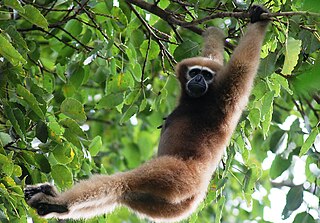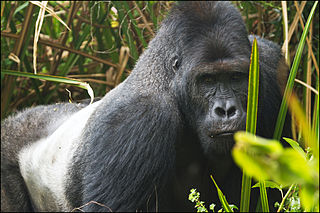
The chimpanzee, also simply known as the chimp, is a species of great ape native to the forests and savannahs of tropical Africa. It has four confirmed subspecies and a fifth proposed one. When its close relative the bonobo was more commonly known as the pygmy chimpanzee, this species was often called the common chimpanzee or the robust chimpanzee. The chimpanzee and the bonobo are the only species in the genus Pan. Evidence from fossils and DNA sequencing shows that Pan is a sister taxon to the human lineage and is thus humans' closest living relative. The chimpanzee is covered in coarse black hair, but has a bare face, fingers, toes, palms of the hands, and soles of the feet. It is larger and more robust than the bonobo, weighing 40–70 kg (88–154 lb) for males and 27–50 kg (60–110 lb) for females and standing 150 cm.

Gorillas are herbivorous, predominantly ground-dwelling great apes that inhabit the tropical forests of equatorial Africa. The genus Gorilla is divided into two species: the eastern gorilla and the western gorilla, and either four or five subspecies. The DNA of gorillas is highly similar to that of humans, from 95 to 99% depending on what is included, and they are the next closest living relatives to humans after chimpanzees and bonobos.

Orangutans are great apes native to the rainforests of Indonesia and Malaysia. They are now found only in parts of Borneo and Sumatra, but during the Pleistocene they ranged throughout Southeast Asia and South China. Classified in the genus Pongo, orangutans were originally considered to be one species. From 1996, they were divided into two species: the Bornean orangutan and the Sumatran orangutan. A third species, the Tapanuli orangutan, was identified definitively in 2017. The orangutans are the only surviving species of the subfamily Ponginae, which diverged genetically from the other hominids between 19.3 and 15.7 million years ago.

Primates are the members of a diverse order of mammals. They are divided into the strepsirrhines, which include the lemurs, galagos, and lorisids, and the haplorhines, which include the tarsiers and the simians. Primates arose 85–55 million years ago first from small terrestrial mammals, which adapted to living in the trees of tropical forests: many primate characteristics represent adaptations to life in this challenging environment, including large brains, visual acuity, color vision, a shoulder girdle allowing a large degree of movement in the shoulder joint, and dexterous hands. Primates range in size from Madame Berthe's mouse lemur, which weighs 30 g (1 oz), to the eastern gorilla, weighing over 200 kg (440 lb). There are 376–524 species of living primates, depending on which classification is used. New primate species continue to be discovered: over 25 species were described in the 2000s, 36 in the 2010s, and six in the 2020s.

The mountain gorilla is one of the two subspecies of the eastern gorilla. It is listed as endangered by the IUCN as of 2018.

The purple-faced langur, also known as the purple-faced leaf monkey, is a species of Old World monkey that is endemic to Sri Lanka. The animal is a long-tailed arboreal species, identified by a mostly brown appearance, dark face and a very shy nature. The species was once highly prevalent, found in suburban Colombo and the "wet zone" villages, but rapid urbanization has led to a significant decrease in the population level of the monkeys. It had traditionally been classified within the genus Trachypithecus but was moved to the genus Semnopithecus based on DNA evidence indicating that is it more closely related to the gray langurs.
The Bili apes, or Bondo mystery apes, were names given in 2003 in sensational reports in the popular media to a purportedly new species of highly aggressive, giant ape supposedly inhabiting the wetlands and savannah around of the village of Bili in the Democratic Republic of the Congo. "The apes nest on the ground like gorillas, but they have a diet and features characteristic of chimpanzees", according to a 2003 National Geographic article.

The hoolock gibbons are three primate species of genus Hoolock in the gibbon family, Hylobatidae, native to eastern Bangladesh, Northeast India, Myanmar, and Southwest China.

The western lowland gorilla is one of two Critically Endangered subspecies of the western gorilla that lives in montane, primary and secondary forest and lowland swampland in central Africa in Angola, Cameroon, Central African Republic, Republic of the Congo, Democratic Republic of the Congo, Equatorial Guinea and Gabon. It is the nominate subspecies of the western gorilla, and the smallest of the four gorilla subspecies.

The Cross River gorilla is a critically endangered subspecies of the western gorilla. It was named a new species in 1904 by Paul Matschie, a mammalian taxonomist working at the Humboldt University Zoological Museum in Berlin, but its populations were not systematically surveyed until 1987.

The eastern lowland gorilla or Grauer's gorilla is a Critically Endangered subspecies of eastern gorilla endemic to the mountainous forests of eastern Democratic Republic of the Congo. Important populations of this gorilla live in the Kahuzi-Biega and Maiko National Parks and their adjacent forests, the Tayna Gorilla Reserve, the Usala forest and on the Itombwe Massif.

The Sumatran orangutan is one of the three species of orangutans. Critically endangered, and found only in the north of the Indonesian island of Sumatra, it is rarer than the Bornean orangutan but more common than the recently identified Tapanuli orangutan, also found in Sumatra. Its common name is based on two separate local words, "orang" and "hutan" ("forest"), derived from Malay, and translates as 'person of the forest'.

The silvery woolly monkey, also known as Poeppig's woolly monkey or the red woolly monkey, is a subspecies of the common woolly monkey from South America. Named after the German zoologist Eduard Friedrich Poeppig, it is found in Brazil, Ecuador and Peru.

The eastern gorilla is a critically endangered species of the genus Gorilla and the largest living primate. At present, the species is subdivided into two subspecies. There are 6,800 eastern lowland gorillas or Grauer's gorillas and 1,000 mountain gorillas. Illegal hunting threatens the species.

The black-shanked douc is an endangered species of douc found mostly in the forests of Eastern Cambodia, with some smaller populations in Southern Vietnam. The region they are mostly found in is called the Annamite Range, a mountainous area that passes through Cambodia and Vietnam. Its habitat is mostly characterized by evergreen forest in the mountains, in the middle to upper canopy. They move around quadrupedally and by brachiation up in the trees. This species is unique with its coloration among the doucs as it has a bluish face with yellow rings around its eyes a blue scrotum and a pink penis. Like other doucs, this specie has a tail as long as its body and head length. Black-shanked douc have been observed in groups ranging from 3 to 30 individuals, depending on their habitat. Group tend to have a fission-fusion dynamic that changes with food availability. Their diet varies from dry to wet season. Regardless of the season, their diet consists mostly of leaves, but they have also been found to consume considerable amounts of fruits and flowers during wet season. The species changed conservation status in 2015 from endangered to critically endangered in the IUCN Red List of Endangered Species. This reassessment is due to an increase of the rate of population decline. No global population estimate exists. The majority of the population can be found in Cambodia, with smaller populations in Vietnam. In fact, the Wildlife Conservation Society reports almost 25,000 individuals in Cambodia's Keo Seima Wildlife Sanctuary, a population that has remained stable over the last decade. The largest populations estimated to be in Vietnam is around 500-600 individuals. The biggest challenges that the black-shanked douc faces in terms of conservation are habitat loss and illegal poaching. Conservation efforts are being made to control illegal poaching and trade in Vietnam by putting laws against hunting and trading threatened species.

The central chimpanzee or the tschego is a subspecies of chimpanzee. It can be found in Central Africa, mostly in Gabon, Cameroon, Republic of Congo and the Democratic Republic of Congo.

The Hominidae, whose members are known as the great apes or hominids, are a taxonomic family of primates that includes eight extant species in four genera: Pongo ; Gorilla ; Pan ; and Homo, of which only modern humans remain.

Mbeli Bai is a 12.9 hectare protected freshwater swamp forest, part of the Sangha Trinational Forest and the Western Congolian swamp forests ecoregion, in the Nouabalé-Ndoki National Park in the Republic of the Congo. The area is commonly used for research on wild gorillas and elephants.
The Afi Mountain Wildlife Sanctuary in Cross River State in southern Nigeria covers 104 km2 (40 sq mi). The wildlife sanctuary was founded in 2000 to provide refuge for endangered animal species, including the Cross River gorilla, the Nigeria-Cameroon chimpanzee, the drill and the gray-necked rockfowl.

Robust capuchin monkeys are capuchin monkeys in the genus Sapajus. Formerly, all capuchin monkeys were placed in the genus Cebus. Sapajus was erected in 2012 by Jessica Lynch Alfaro et al. to differentiate the robust (tufted) capuchin monkeys from the gracile capuchin monkeys, which remain in Cebus.

























